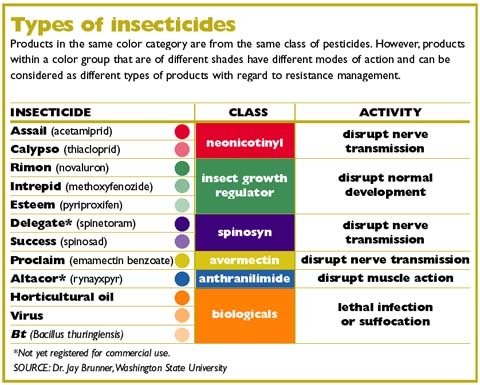Project Description
Pest Control
Featured stories about pest control appear in this issue.
Drift is a chronic grape problem
An example of phenoxy herbicide drift damage to grapes. Although much progress has been made in reducing vineyard injury from phenoxy, hormone-mimic herbicides, don’t expect
Banana Terrorists or New Era?
When Dave Carlson called me on editorial deadline and said that he thought it was time for growers to spend money—and would we promote the
Looking for a pesticide solution
When Jim Hazen went to Olympia this legislative session to represent the tree fruit growers of Washington State, he had the solution even before the
Plenty of options for pest control
Growers have plenty of insecticides to choose from for controlling the key apple pests codling moth and leafrollers. Including two new pesticides that will be
Switching new products for old
Washington State University and the Washington tree fruit industry are proposing a major effort to help orchardists transition away from organophosphate pesticides. The three-year project,
Phasing out Guthion
The U.S. Environmental Protection Agency is phasing out use of the organophosphate pesticide Guthion (azinphos-methyl) over a number of years to give growers time to
Timing is critical
Vince Jones developed the Decision-Aid System to help growers with pest management. Timing is everything in pest management. Say you’re sampling for leafrollers. If you
Managing pesticide drift
Under certain weather conditions, sprays don’t always stay where they are intended. Pesticide residues are detected in many places where they are not intended, including
Putting buffers to work
This living barrier in the middle is part of an Oregon State University study to measure how much drift is trapped from applications made in
Thinning may affect mite control
Rust mites are an alternate prey for predator mites. Orchardists used to tell Dr. Elizabeth Beers that they hadn’t sprayed for mites in 25 years
Alternative pest controls
Pest control is not easy for tree fruit growers, who face resistance and regulatory challenges, as well as pressure from neglected orchards. But new products
Sweet solution stays on the shelf
A pesticide made from sugar esters is being used by beekeepers to control the varroa mite, but is not yet being marketed for controlling orchard
Low-cost fence keeps deer out
This inexpensive but effective deer fence was built for about 40 cents per foot and can be lifted up at the bottom for mowing. A
Europe irked by wine tax break
A tax exemption for Canadian wineries has drawn the ire of the European Union, which has hauled Canada before the World Trade Organization in a
Good Question: And the greatest breakthrough in orchard pest control would be…?
Larry GutMichigan State University, East Lansing "Totally effective mating disruption." Gut and his colleagues have set a goal to develop a high-performance mating disruption system
Apple maggot found in B.C.
Grape growers aren’t the only ones confronting new pests. The Canadian Food Inspection Agency is battling two new apple pests in British Columbia. Apple maggot,
New mites invade Washington vineyards
Two new grape mites, the rust mite and the bud mite, can reduce yields from stunted shoot growth, as seen here. New mites showing up
Exclusion is your first defense
Site preparation is the first step to preventing pests and diseases from becoming a problem in the vineyard, and in the case of crown gall
New pests threaten B.C. grapes
The growing movement of goods and people worldwide increases the risk that new pests will invade vineyards in North America and around the world. “Invasive
Future challenges for genebanks
Condensed from: J. Postman, K. Hummer, E. Stover, R. Krueger, P. Forsline, L.J. Grauke, F. Zee, T. Ayala-Silva, B. Irish. 2006. Fruit and Nut Genebanks
B.C. growers support survival strategy
Integration, innovation, and quality enhancement have been embraced as the roads to a revitalized tree-fruit industry in British Columbia, Canada. A comprehensive, industrywide strategic plan
Growing more cherries
LEFT: Bill Warmerdam and son John grow and pack their own tree fruit in addition to packing cherries, apples, and kiwis for other growers. BELOW:
Breeders aim for a perfect cherry
Left: Sentennial is a new late-season cherry from British Columbia. Right: Sovereign was named in honor of Queen Elizabeth’s 80th birthday. The perfect cherry variety,
Apple maggot on the move
Left: The apple maggot is about the size of a house fly and has distinctive markings on its wings, a white patch on its
Cherry growers take the bait
An insecticide-laced bait that is squirted on trees to control cherry fruit fly has saved growers an estimated $2.75 million over the past three years,
Consistent Quality Key to Profitability
The 2006-2007 crop marketing year is approaching the halfway mark. Prices and demand for Washington apples continue to be strong as we move through a
Codling Moth Has a New Calendar
Fundamental to the effective management of codling moth in Washington State orchards has been the use of a simple predictive model to time the first
Don’t grow small cherries
An oversupply of small cherries last season hurt growers financially. Fifty-six percent of the Pacific Northwest’s fresh sweet cherry crop was in sizes 11 to












